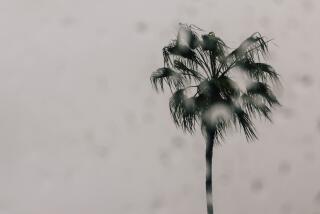Storm puts residents of fire zones on the defensive
As a Pacific storm descended Tuesday night on Southern California, residents waited nervously to see whether rainfall would trigger mudslides in wildfire-ravaged areas.
People stacked sandbags and positioned heavy concrete barriers against hillsides, transforming their homes into fortified bunkers.
The storm system was first expected to dump 3 to 6 inches of rain in wildfire-charred areas in Los Angeles County. But the National Weather Service said that the system had weakened Tuesday afternoon after battering Northern California with heavy rainfall, and that L.A. County mountain areas would receive up to 4 inches of rain. About half an inch of rain was expected in valleys and along the coast.
By Tuesday night, less than two-tenths of an inch of rain had fallen in coastal and valley areas in L.A. County, and about 1 1/2 inches had fallen in the Angeles National Forest, according to the weather service.
Still, officials and residents had prepared for the worst.
The Los Angeles County Fire Department said Tuesday that it had beefed up stations in the foothill areas with additional firefighters to staff two-person units that would patrol areas prone to mudslides.
Big Tujunga Canyon Road was closed 1 1/2 miles north of Mount Gleason Avenue to Angeles Forest Highway. And Aliso Canyon Road was closed in the Angeles National Forest, the California Highway Patrol said.
The Pacific storm was being pushed by strong winds blowing from the south, which were expected to intensify rainfall on south-facing mountain slopes that burned from Altadena to Acton during the 160,000-acre Station fire that broke out in August.
Winds were expected to reach 35 to 40 mph, with gusts as high as 60 mph, according to the weather service.
More than 30,000 customers were left without power in Los Angeles. By Tuesday night, power had been restored to about 20,000 people, the Los Angeles Department of Water and Power said.
In the Bay Area, the storm caused power outages and flooding. Officials in Santa Cruz County, meanwhile, ordered homes evacuated in mountain areas where summer wildfires had burned.
The California Independent System Operator, which oversees the state’s electricity grid, declared an emergency Tuesday afternoon after strong winds knocked down a major transmission line in Moss Landing, in Monterey County. The amount of electricity flowing on the line, a major north-south connection, was reduced by about one-third.
In Southern California, flood watches were extended to areas burned by the Sheep fire near Wrightwood as well as areas burned by the Sayre and Marek fires last year in the San Fernando Valley area.
In Glendale, Paul Dutton worked amid a steady rain, unloading sandbags from his blue truck Tuesday afternoon near the corner of Boston Avenue and Markridge Road.
He hoped the bags would help protect a friend’s home from potential mud flows. As Dutton worked, dull gray clouds hung low in the shadow of Deukmejian Wilderness Park, an area that has been pegged as a prime location for mudslides. The park was almost completely burned by the Station fire that broke out in August in the Angeles National Forest and spread to adjacent foothill communities.
“There is no vegetation left to hold back any soil. In a normal rain year, we have slides. Now we have rain without the benefit of vegetation,” said Russ Hauck, a senior park naturalist who has worked for the city for 17 years. “We’re anticipating that we’ll definitely get some sort of slide.”
He said crews have placed tiered levels of concrete K-rail barriers throughout the park in hopes that they would slow any debris flows.
“The hillside behind the nature center looks like a defensive lineman waiting for the ball to be snapped,” he said.
--
Times staff writer Tony Barboza contributed to this report
More to Read
Sign up for Essential California
The most important California stories and recommendations in your inbox every morning.
You may occasionally receive promotional content from the Los Angeles Times.











